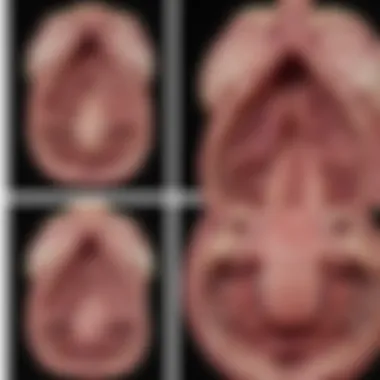Understanding Rectal Cancer Staging and Prognosis


Intro
Rectal cancer staging involves categorizing the disease based on various parameters, including tumor size, regional lymph node involvement, and the presence of metastasis. Understanding these stages is essential for both treatment planning and evaluating patient prognosis. In this context, we will explore the intricacies of rectal cancer staging, focusing on classifications such as the TNM system, the use of imaging techniques for accurate diagnosis, and how different stages influence treatment approaches.
Article Overview
Purpose of the Article
The primary aim of this article is to provide a thorough examination of rectal cancer staging. It will articulate the significance of accurate staging in formulating personalized treatment strategies and improving patient outcomes. Given the complexity of rectal cancer, having a deep understanding of its staging is beneficial for clinicians and healthcare professionals.
Relevance to Multiple Disciplines
Staging rectal cancer is not solely a concern for oncologists. It also connects to various medical disciplines, including surgery, radiology, and pathology. Each field contributes to a comprehensive approach to patient care.
Accurate staging enables healthcare professionals to make informed decisions about treatment options, maximizing the potential for positive patient outcomes.
Accurate staging enables healthcare professionals to make informed decisions about treatment options, maximizing the potential for positive patient outcomes.
Research Background
Historical Context
The history of cancer staging can be traced back to the early developments in oncology. Initially, staging was rather simplistic and primarily based on physical examinations. Over decades, with advancements in imaging technologies and a better understanding of tumor biology, more sophisticated systems have emerged, leading to the establishment of methods like the TNM classification that we use today.
Key Concepts and Definitions
Understanding specific terminology is imperative when discussing rectal cancer staging:
- Tumor (T): Indicates the size and extent of the primary tumor.
- Node (N): Refers to the involvement of regional lymph nodes by cancer cells.
- Metastasis (M): Describes if the cancer has spread to other parts of the body.
In this article, we will delve into each of these components, exploring their implications for the staging process and subsequent treatment options.
This comprehensive overview will guide the reader through the critical aspects of rectal cancer staging, substantively enriching their understanding of its vital role in the continuum of cancer care.
Understanding Rectal Cancer
Understanding rectal cancer is essential in grasping the complexities of its diagnosis, treatment, and overall management. This foundation serves as the backbone for the entire staging process, influencing how healthcare professionals approach treatment planning and patient care. Awareness of rectal cancer's character, including its biological behavior and potential progression, is crucial for both patients and clinicians alike. The progression of this cancer type can have serious implications while recognizing its signs early can contribute significantly to positive outcomes.
Definition and Prevalence
Rectal cancer is defined as the malignancy that develops in the rectum, typically arising from precancerous polyps. These polyps, if left unchecked, can evolve into carcinoma over time. Rectal cancer is part of the broader category of colorectal cancer, which includes cancers of the colon and rectum.
According to cancer research statistics, rectal cancer represents a significant proportion of new cancer diagnoses worldwide. It is estimated that the incidence rate has been increasing over recent years, particularly among younger populations. This growing prevalence calls for heightened awareness and effective screening strategies.
Risk Factors and Causes
Numerous risk factors contribute to the development of rectal cancer. These can be categorized into non-modifiable and modifiable factors. Non-modifiable risks include age, genetics, and family history. Older adults, particularly those over the age of 50, are at increased risk as well as individuals with hereditary conditions such as Lynch syndrome or familial adenomatous polyposis.
On the other hand, modifiable factors can be influenced through lifestyle changes. Diet high in red and processed meats, sedentary behavior, smoking, and obesity have all been identified as significant contributors. Understanding these risk factors helps underscore preventive measures and the importance of regular screenings.
Symptoms and Signs
Recognizing the symptoms of rectal cancer is crucial for early detection. Some common signs include:
- Changes in bowel habits, which may include constipation or diarrhea
- Presence of blood in the stool
- Unexplained weight loss
- Abdominal pain or discomfort
- A feeling of incomplete evacuation after bowel movements
These symptoms can easily be attributed to other conditions, which can delay diagnosis. Establishing the connection between symptoms and their potential implication of rectal cancer can lead to timely interventions. Awareness of these signals encourages individuals to seek medical help sooner rather than later, potentially improving the prognosis.
The Importance of Staging
Staging of rectal cancer is crucial because it provides an essential framework for making informed treatment decisions and assessing patient prognosis. The stage of cancer indicates its extent and severity, which directly influences the therapeutic approaches that may be appropriate for a patient. Thus, understanding the importance of staging cannot be understated in the context of rectal cancer management.
When healthcare providers determine the stage, they utilize the well-established TNM classification system, distinguishing between the size of the tumor, the involvement of lymph nodes, and the presence of metastasis. Each of these factors provides insight into the progression of the disease and helps tailor treatment strategies accordingly. For instance, early-stage rectal cancer may only require surgery, while advanced stages could necessitate a combination of surgery, chemotherapy, or radiation therapy.
Furthermore, staging is vital for prognostics. It allows medical professionals to estimate survival rates and the likelihood of recurrence based on empirical data gathered from similar patient profiles. This understanding not only aids in guiding patient and family decisions but also facilitates clinical trial enrollments, as many trials are stage-specific, aiming to assess the effectiveness of new treatments at certain disease stages.
"Accurate staging is the bedrock of a tailored treatment plan, enabling optimized outcomes for patients with rectal cancer."
"Accurate staging is the bedrock of a tailored treatment plan, enabling optimized outcomes for patients with rectal cancer."
In essence, staging serves dual purposes: It aids in navigating the complexities of treatment options and enhances the overall understanding of patient prognosis. By meticulously evaluating the various aspects of staging, healthcare providers can deliver personalized care that aligns with the patient's unique situation, ultimately improving the chances for successful outcomes.
The TNM Staging System
The TNM staging system is crucial in the evaluation of rectal cancer. It provides a structured approach to categorize the disease based on three components: Tumor (T), Node (N), and Metastasis (M). By using this system, clinicians can assess the extent of the cancer, which is essential in crafting a personalized treatment plan and predicting outcomes. The TNM system not only improves communication among healthcare professionals but also enhances the ability to compare patient outcomes across different institutions. Because of its systematic approach, the TNM classification is widely accepted worldwide.
Overview of TNM Components
The TNM components are interlinked and offer a comprehensive view of the cancer's seriousness. The 'T' component addresses the size and extent of the primary tumor. The 'N' component focuses on whether cancer has spread to lymph nodes. Lastly, the 'M' component reveals whether distant metastasis has occurred. Together, these three elements create a uniform framework for staging that helps predict prognosis and guide treatment. The clarity and uniformity offered by this system is beneficial for both clinicians and patients, as it allows for informed decisions to be made regarding treatment options.
Tumor (T) Classification


The T classification is divided into stages T1 to T4, which indicates the tumor's size and extent of invasion into surrounding tissues.
T1 - T4 Classification
The T1 - T4 classification serves as a fundamental aspect of the TNM system. It categorizes tumors based on their progression. T1 indicates that the tumor is small and superficial, while T4 signifies a larger tumor that has invaded nearby structures or organs. This clear classification allows healthcare professionals to compare treatment options more effectively. The benefit of this classification is that it gives specific guidance concerning surgical interventions and adjunct therapies. However, it can also create confusion if not understood properly by the patient or caregivers.
Depth of Invasion
Depth of invasion refers to how deeply the tumor has penetrated the rectal wall and surrounding tissues. This aspect is vital because it significantly influences staging and consequently the treatment strategy. The key characteristic of depth of invasion helps to assess whether the tumor is confined to the rectal wall or has progressed to nearby structures. While this detail is vital for surgical planning and prognosis, understanding it may be complex, leading to potential misunderstandings among patients who are not familiar with oncological terms.
Node (N) Classification
Node classification is another core component of the TNM system, focusing on regional lymph node involvement.
Regional Lymph Nodes
The involvement of regional lymph nodes indicates the extent of spread. The presence of cancerous cells in nearby lymph nodes implies a more advanced disease, which can lead to modified treatment approaches. The key characteristic of this classification is that it helps in evaluating the risk of metastasis and the necessity for aggressive treatment options. Its downside is that staging based on lymph node involvement can vary due to differences in detection techniques.
Nodal Involvement
Nodal involvement encompasses the degree to which the lymph nodes are affected. This element is essential for determining prognosis and therapy. High nodal involvement suggests a poorer prognosis. The prognostic information provided by this aspect is valuable for the multidisciplinary treatment team. However, the implications of nodal involvement can be overwhelming for patients, necessitating careful explanation from healthcare providers.
Metastasis () Classification
The M classification looks at whether cancer has metastasized beyond the rectum.
Distant Metastasis
Distant metastasis indicates whether the cancer has spread to remote organs, such as the liver or lungs. The key characteristic of distant metastasis is that it significantly alters treatment protocols. If metastasis is present, treatment often shifts towards systemic therapies rather than local treatments. The downside is that metastatic cancer generally signifies a much poorer prognostic outlook, which can be distressing for patients and their families.
M0 and M1 Categories
The M0 and M1 categories specify the absence or presence of distant metastasis. M0 means no distant spread, while M1 indicates that metastases are present. This clear categorization is helpful because it guides treatment decisions, particularly concerning the aggressiveness of therapy. A challenge arises in distinguishing between M0 and M1, as determining the presence of metastasis can be complex and requires thorough imaging and clinical evaluations.
Imaging Techniques in Staging
Imaging techniques play a crucial role in the staging of rectal cancer. Accurate staging is essential as it influences treatment decisions and helps to assess prognosis. Various imaging modalities provide different insights into the anatomical and pathological features of the cancer, aiding healthcare providers in making informed decisions regarding patient management.
Using these imaging techniques, doctors can determine tumor size, depth of invasion, and any metastasis to regional lymph nodes or distant sites. This information is vital to tailoring appropriate treatment plans. The benefits and considerations surrounding each imaging method should be clearly understood.
Endorectal Ultrasound
Endorectal ultrasound (EUS) is a specialized imaging technique that is particularly useful for assessing early-stage rectal cancer. It involves inserting a small ultrasound probe into the rectum, allowing for high-resolution images of the rectal wall and surrounding structures.
The strengths of EUS include:
- Detection of Tumor Depth: EUS can accurately measure how deeply a tumor has invaded the rectal wall, categorized typically into layers.
- Evaluation of Lymph Nodes: It assists in identifying enlarged lymph nodes that could indicate regional spread of cancer.
- Minimal Invasiveness: As a non-surgical procedure, it is generally well-tolerated, providing significant information without major risks to the patient.
However, there are limitations. EUS has a learning curve, and its effectiveness can be limited in obese patients or when tumors are located in certain areas of the rectum. Overall, EUS remains an important tool in the early detection and assessment of rectal cancer.
Magnetic Resonance Imaging (MRI)
Magnetic Resonance Imaging (MRI) is another critical imaging modality, especially in the preoperative evaluation of rectal cancer. MRI is recognized for its ability to provide superior soft tissue contrast, making it well-suited for visualizing the rectum and nearby organs.
Key aspects of using MRI include:
- Detailed Assessment of Tumor Location: MRI provides a comprehensive view, allowing for the assessment of tumor size and local invasion or infiltration into surrounding structures such as the mesorectum.
- Avoidance of Ionizing Radiation: Unlike CT scans, MRI does not use ionizing radiation, making it safer for repeated imaging.
- Staging Accuracy: MRI has shown effectiveness in accurate staging and can differentiate between T1 through T4 tumors, enhancing the ability to plan for surgical and non-surgical options effectively.
The implementation of MRI, however, can be expensive and may not be universally available. Additionally, the interpretation of images requires expertise.
Computed Tomography (CT) Scan
Computed Tomography (CT) scans are commonly used in the evaluation of rectal cancer, particularly for staging and detecting metastasis. They are quick, widely available, and can cover a broader area compared to other modalities.
Important features of CT scans include:
- Assessment of Distant Metastasis: CT is particularly valuable for evaluating potential lung and liver metastases, which are common in advanced rectal cancer.
- Rapid Imaging: The speed of obtaining a CT scan can facilitate urgent treatment planning decisions.
- Guidance for Biopsies: CT imaging can help in guiding biopsy procedures when cancer spread is suspected but needs confirmation.
Nevertheless, CT scans have limited capabilities in assessing the rectal wall itself and surrounding soft tissues. They are less precise than MRI and EUS for local staging of rectal tumors.
The choice of imaging technique often depends on factors such as tumor characteristics, patient health, and available resources.
The choice of imaging technique often depends on factors such as tumor characteristics, patient health, and available resources.
Pathological Examination
Pathological examination is a cornerstone of rectal cancer staging. It provides critical insights necessary for the accurate classification and management of the disease. A robust assessment through pathology enables healthcare professionals to understand the nature of the tumor, its aggressiveness, and its potential to spread. This examination often involves analyzing tissue samples obtained via biopsy.
By evaluating the cellular and tissue characteristics of the cancer, pathologists can offer essential data that directly influences treatment decisions. Advanced techniques in pathology enhance the precision of staging and subsequently improve patient outcomes.
Biopsy Techniques


Biopsy techniques are vital in diagnosing rectal cancer and determining the stage of the disease. Among the most common methods are endoscopic biopsies, which involve the use of a flexible tube with a camera and tools to collect tissue samples from the rectum. This technique is precise; it allows for direct visualization of the tumor and surrounding tissues.
Another method is the core needle biopsy, which is less commonly used for rectal cancer but still applicable in some cases. It retrieves larger samples of tissue, providing a more comprehensive understanding of tumor properties.
Regardless of the method used, the importance of obtaining quality biopsy samples cannot be overstated. Factors to consider include:
- The location of the tumor.
- The size of the tumor.
- The expertise of the medical staff.
Histopathological Evaluation
Histopathological evaluation follows the biopsy process. This step involves microscopic examination of the acquired tissue samples. Pathologists assess the architecture of the tissue, cell types present, and any signs of malignancy.
Evaluation can determine several factors:
- Tumor type: Identifying whether the tumor is adenocarcinoma, squamous cell carcinoma, or another type can influence treatment choices.
- Grade of differentiation: Understanding how closely the tumor cells resemble normal cells helps in determining the aggressiveness of the cancer, guiding therapeutic strategies.
- Lymphovascular invasion: This indicates whether cancer has spread to nearby blood vessels or lymphatics, critical for staging and treatment.
Overall, pathological examination, including biopsy techniques and histopathological evaluation, is crucial in the thorough understanding of rectal cancer. These processes significantly contribute to establishing an accurate stage, guiding treatment, and ultimately influencing patient survival rates.
"Pathological examination is not just a step in staging; it is often the linchpin upon which effective treatment pivots."
"Pathological examination is not just a step in staging; it is often the linchpin upon which effective treatment pivots."
Stage-Specific Treatment Approaches
Stage-specific treatment approaches are essential in the management of rectal cancer. Such strategies are tailored to the specific characteristics of the tumor and its progression in the individual patient. By customizing the treatment according to the stage, healthcare providers can optimize outcomes, minimize side effects, and ultimately enhance patient quality of life.
Localized Disease Management
Surgery
Surgery is often the primary treatment for localized rectal cancer. The goal of the surgery is to remove the cancerous tumor along with a margin of healthy tissue surrounding it. This approach has a key characteristic: it can be curative for patients with early-stage disease. The popular choice of surgery is based on its ability to potentially eradicate the cancer completely.
One unique feature of surgery for rectal cancer is the variety of surgical techniques available, such as resection or colostomy. Each method has its own advantages and disadvantages. For instance, while a resection may preserve normal bowel function, it can also carry risks of complications such as infection or bleeding. On the other hand, a colostomy may prevent issues but can significantly affect the patient’s lifestyle.
Radiation Therapy
Radiation therapy plays a significant role in localized disease management, particularly in cases where surgery alone may not suffice. It uses high-energy rays to target and destroy cancer cells. A key characteristic of radiation therapy is its capacity to shrink tumors before surgery, which can improve surgical outcomes. This makes it a beneficial choice for patients who may have larger tumors.
The distinctive aspect of radiation therapy is that it can also be used post-operatively to eliminate any remaining cancer cells. One advantage is its ability to target the tumor with minimal effect on surrounding tissues. However, it can have side effects, including fatigue and skin irritation, which must be managed carefully.
Regional Disease Management
Chemotherapy
Chemotherapy is commonly used in the treatment of regional disease, particularly when the cancer has spread to nearby lymph nodes. It involves using drugs to kill or slow down cancer cells. One key aspect of chemotherapy is that it can be administered before or after surgery, depending on the individual case. This flexibility makes it a popular choice among treatment plans.
A unique feature of chemotherapy is its systemic nature. It can address microscopic disease that is not visible during imaging. However, it is also associated with several side effects, such as nausea and weakened immune function. Understanding these effects is important for patients to make informed decisions about their care.
Targeted Therapy
Targeted therapy focuses on specific characteristics of cancer cells and is generally reserved for patients with certain biomarker profiles. The key characteristic of targeted therapy is its precision; it aims to attack only the cancer cells, sparing normal cells. This specificity makes it an appealing option for patients with advanced rectal cancer.
The unique feature of targeted therapy is the minimal damage it can cause to healthy tissues, resulting in fewer side effects compared to traditional chemotherapy. However, its role is still evolving, with ongoing research necessary to expand its application in rectal cancer treatment.
Metastatic Disease Management
Palliative Care
When rectal cancer progresses to a metastatic stage, palliative care becomes an important focus. This approach aims to improve the quality of life for patients by alleviating symptoms rather than attempting to cure the disease. The key characteristic of palliative care is its holistic perspective, addressing both physical and emotional needs.
A unique aspect of palliative care is its adaptability. It can be integrated alongside curative treatments or can stand alone when a cure is not possible. Benefits include enhanced comfort and support. However, some may see it as a last resort, not recognizing its value throughout the illness journey.
Clinical Trials
Clinical trials represent a critical component in the management of metastatic rectal cancer. They provide access to cutting-edge therapies not yet widely available. The primary feature of clinical trials is their potential to introduce innovative treatment options that could significantly improve outcomes.
These trials offer patients a chance to contribute to medical advancements and possibly benefit from new therapies. Nevertheless, participation may not guarantee success and could involve additional testing or treatment protocols that might be outside standard care.
"Stage-specific treatment approaches are fundamental to optimizing care for rectal cancer patients across all stages of the disease."
"Stage-specific treatment approaches are fundamental to optimizing care for rectal cancer patients across all stages of the disease."
Prognostic Factors Beyond Staging
Staging is essential in rectal cancer management, but it does not tell the whole story. Prognostic factors beyond staging offer deeper insights into patient outcomes and tailored treatment approaches. Here, we explore two significant areas: the role of molecular markers and the impact of patient health and comorbidities.
Molecular Markers
Molecular markers serve as biological indicators that can provide extra information on cancer behavior. For rectal cancer, specific markers can help predict how aggressive the disease might be or how well a patient might respond to a particular treatment. Examples include:


- KRAS Mutation: This mutation is often found in colorectal cancers and informs about the tumor's behavior. Patients with KRAS mutations may respond differently to targeted therapies.
- MSI (Microsatellite Instability): High levels of MSI are linked to a better prognosis and can indicate that certain immunotherapies may be effective.
The identification of these markers can guide oncologists in making informed decisions regarding treatment selection. They allow for personalized medicine, thus optimizing outcomes for the patient.
Patient Health and Comorbidities
The overall health of a patient plays a critical role in the prognosis of rectal cancer. Comorbidities or existing health conditions can influence cancer treatment's effectiveness and tolerance. Some important aspects to consider are:
- Age: Older patients may face different risks and have unique treatment considerations compared to younger individuals.
- Existing Medical Conditions: Conditions like diabetes, heart disease, or other chronic illnesses may complicate treatment options and recovery.
- Lifestyle Factors: Factors such as diet, smoking, and exercise habits can also affect outcomes.
Understanding these factors helps in creating a comprehensive treatment plan. Oncologists must consider not only the cancer stage but also how other aspects of a patient’s health may influence treatment decisions and expected outcomes.
For instance, managing a patient with rectal cancer who also suffers from cardiovascular illness needs a balanced approach. The treatment plan should minimize risks while maximizing the chance for remission.
For instance, managing a patient with rectal cancer who also suffers from cardiovascular illness needs a balanced approach. The treatment plan should minimize risks while maximizing the chance for remission.
In summary, while staging provides a framework for assessing rectal cancer, integrating molecular markers and evaluating patient health are essential to predicting prognosis and enhancing treatment outcomes. Effective management requires a multifaceted approach that considers all elements affecting the patient's health.
Current Research Trends in Rectal Cancer Staging
Research trends in rectal cancer staging are evolving rapidly. New findings are crucial for enhancing patient treatment pathways and improving outcomes. Researchers are emphasizing the refinement of existing staging criteria and the adoption of innovative diagnostic technologies. These elements are not only vital for accurate staging but also for tailoring treatment to individual patient needs.
The advancements in this field provide a roadmap to better understand the complexities of rectal cancer progression. As the scientific community delves deeper into molecular and genetic factors, there is promise of refining classification systems that account for more than just direct tumor characteristics. The focus is on precise data that guides treatment plans.
"Advances in research will help clinicians improve diagnostic accuracy, shaping future treatment protocols for rectal cancer patients."
"Advances in research will help clinicians improve diagnostic accuracy, shaping future treatment protocols for rectal cancer patients."
Emerging Diagnostic Technologies
Emerging diagnostic technologies play a pivotal role in rectal cancer staging. Tools such as liquid biopsies and advanced imaging modalities offer insights that were previously unattainable. Liquid biopsies enable the detection of circulating tumor DNA, providing non-invasive methods for assessing tumor dynamics and response to treatment.
Key technologies include:
- Endorectal Ultrasound (ERUS): Improved imaging accuracy for local staging.
- MRI innovations: High-resolution imaging with functional MRI helps visualize tumor boundaries and response to therapy.
- Positron Emission Tomography (PET): Combines conventional imaging with metabolic information, enhancing the detection of distant metastases.
These technologies support clinicians in making informed treatment decisions and tracking disease progression over time. The incorporation of data from these methods can redefine how staging is approached, potentially shifting the paradigms of treatment protocols.
Adjustments to Staging Criteria
Adjustments to staging criteria are essential to reflect our growing understanding of cancer dynamics. The International Union Against Cancer (UICC) and the American Joint Committee on Cancer (AJCC) continue to update their guidelines to incorporate new research findings.
Recent considerations in adjustments include:
- Molecular Characteristics: Integration of genetic profiling to delineate subtypes of rectal cancer.
- Lymphovascular Invasion: Recognizing its impact on prognosis and treatment options.
- Tumor Biology: Assessing features like histological grade and response to neoadjuvant therapies.
These criteria modifications aim to enhance prognostic accuracy, allowing for more personalized and effective treatment approaches. The ongoing research into these areas will likely lead to further refinements that will benefit patients by improving the precision of the staging process.
Each research trend contributes to a nuanced understanding of rectal cancer, equipping healthcare providers with the tools needed for better patient care.
Patient Education and Support
Patient education and support play a fundamental role in the journey of individuals diagnosed with rectal cancer. Understanding the disease and its implications helps patients make informed choices about their treatment and manage their emotional and physical health effectively. Education empowers patients, reducing anxiety associated with the unknown and allowing them to take an active role in their treatment decisions.
Understanding the Staging Process
The staging process is essential for patients, as it translates medical jargon into comprehensible realities concerning their health. The stages of rectal cancer determine not only the treatment options available but also potential outcomes. Patients who grasp the significance of staging can engage in informed discussions with their healthcare teams.
The understanding of the TNM system is critical. Patients learn how the Tumor size, Node involvement, and Metastasis collectively paint a picture of the disease. Furthermore, this knowledge assists them in understanding the relevance of diagnostic tests, their purpose, and what results might indicate about the progression of their condition. Clear explanations about staging and treatments can also positively influence a patient’s emotional state.
Resources for Patients
Access to reliable resources enables patients to seek further information and support. Various organizations focus on rectal cancer, offering vast educational materials, helplines, and online communities. Here are several useful resources:
- American Cancer Society: Provides comprehensive guides and access to support networks.
- National Cancer Institute: Offers educational materials on the nature and treatment of rectal cancer.
- Reddit communities: Forums for sharing experiences, where individuals can ask questions and find comfort in shared experiences with others.
- Facebook support groups: Social media groups can help patients connect with peers for emotional support and information on coping strategies.
"Education about rectal cancer can transform fear into understanding, leading to better health choices."
"Education about rectal cancer can transform fear into understanding, leading to better health choices."
By leveraging these resources, patients can enhance their knowledge, access necessary support, and feel connected throughout their treatment journey. Establishing a solid support system alongside educational awareness fosters resilience and improves outcomes in their healthcare experience.
Ending
The conclusion of an article about rectal cancer staging serves many significant purposes, especially considering the intricate nature of cancer management. It reiterates the vital aspects of the discussion, bringing together the critical information presented in earlier sections. Without this final summation, readers may miss the broader implications of the details shared.
In this article, we delve into various facets of rectal cancer staging, highlighting how crucial this process is for guiding treatment decisions and evaluating prognosis. Staging is paramount because it informs clinicians about the cancer's extent, enabling personalized treatment strategies. For instance, understanding the TNM classification and imaging techniques aids in determining whether a patient requires surgery, chemotherapy, or palliative care.
"Staging allows healthcare providers to tailor treatment plans effectively, ensuring that patients receive the most appropriate interventions available."
"Staging allows healthcare providers to tailor treatment plans effectively, ensuring that patients receive the most appropriate interventions available."
Moreover, the conclusion emphasizes the importance of patient education regarding staging. Knowing what each stage means can empower patients, helping them to comprehend their situation and engage actively with their healthcare team. Furthermore, providing resources for patients and families enhances understanding and support, underscoring the role that comprehensive care plays in successful treatment outcomes.
Summary of Key Points
- Staging Significance: Rectal cancer staging is crucial in tailoring treatment strategies and assessing prognosis.
- TNM Classification: The TNM system provides a framework for understanding the extent of the disease, covering tumor size, lymph node involvement, and metastasis.
- Impact on Treatment: Different stages of rectal cancer dictate specific management approaches, ranging from surgery to chemotherapy.
- Patient Empowerment: Educating patients about staging offers them a sense of control and enables better discussions with healthcare professionals.
- Resource Availability: Providing patients with access to information and support enhances their overall experience and promotes favorable health outcomes.



